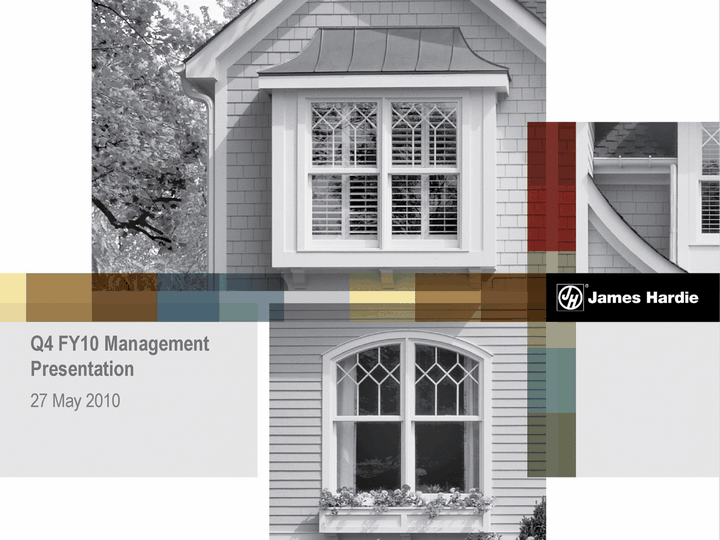

| Q4 FY10 Management Presentation 27 May 2010 |
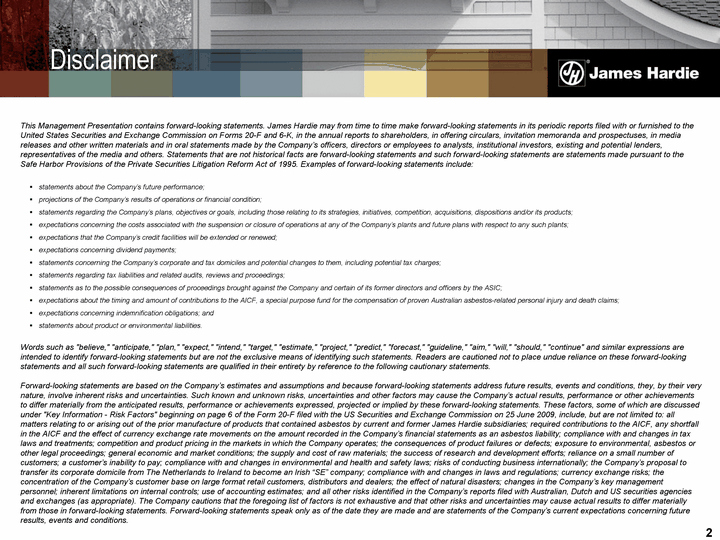
| Disclaimer This Management Presentation contains forward-looking statements. James Hardie may from time to time make forward-looking statements in its periodic reports filed with or furnished to the United States Securities and Exchange Commission on Forms 20-F and 6-K, in the annual reports to shareholders, in offering circulars, invitation memoranda and prospectuses, in media releases and other written materials and in oral statements made by the Company's officers, directors or employees to analysts, institutional investors, existing and potential lenders, representatives of the media and others. Statements that are not historical facts are forward-looking statements and such forward-looking statements are statements made pursuant to the Safe Harbor Provisions of the Private Securities Litigation Reform Act of 1995. Examples of forward-looking statements include: statements about the Company's future performance; projections of the Company's results of operations or financial condition; statements regarding the Company's plans, objectives or goals, including those relating to its strategies, initiatives, competition, acquisitions, dispositions and/or its products; expectations concerning the costs associated with the suspension or closure of operations at any of the Company's plants and future plans with respect to any such plants; expectations that the Company's credit facilities will be extended or renewed; expectations concerning dividend payments; statements concerning the Company's corporate and tax domiciles and potential changes to them, including potential tax charges; statements regarding tax liabilities and related audits, reviews and proceedings; statements as to the possible consequences of proceedings brought against the Company and certain of its former directors and officers by the ASIC; expectations about the timing and amount of contributions to the AICF, a special purpose fund for the compensation of proven Australian asbestos-related personal injury and death claims; expectations concerning indemnification obligations; and statements about product or environmental liabilities. Words such as "believe," "anticipate," "plan," "expect," "intend," "target," "estimate," "project," "predict," "forecast," "guideline," "aim," "will," "should," "continue" and similar expressions are intended to identify forward-looking statements but are not the exclusive means of identifying such statements. Readers are cautioned not to place undue reliance on these forward-looking statements and all such forward-looking statements are qualified in their entirety by reference to the following cautionary statements. Forward-looking statements are based on the Company's estimates and assumptions and because forward-looking statements address future results, events and conditions, they, by their very nature, involve inherent risks and uncertainties. Such known and unknown risks, uncertainties and other factors may cause the Company's actual results, performance or other achievements to differ materially from the anticipated results, performance or achievements expressed, projected or implied by these forward-looking statements. These factors, some of which are discussed under "Key Information - Risk Factors" beginning on page 6 of the Form 20-F filed with the US Securities and Exchange Commission on 25 June 2009, include, but are not limited to: all matters relating to or arising out of the prior manufacture of products that contained asbestos by current and former James Hardie subsidiaries; required contributions to the AICF, any shortfall in the AICF and the effect of currency exchange rate movements on the amount recorded in the Company's financial statements as an asbestos liability; compliance with and changes in tax laws and treatments; competition and product pricing in the markets in which the Company operates; the consequences of product failures or defects; exposure to environmental, asbestos or other legal proceedings; general economic and market conditions; the supply and cost of raw materials; the success of research and development efforts; reliance on a small number of customers; a customer's inability to pay; compliance with and changes in environmental and health and safety laws; risks of conducting business internationally; the Company's proposal to transfer its corporate domicile from The Netherlands to Ireland to become an Irish "SE" company; compliance with and changes in laws and regulations; currency exchange risks; the concentration of the Company's customer base on large format retail customers, distributors and dealers; the effect of natural disasters; changes in the Company's key management personnel; inherent limitations on internal controls; use of accounting estimates; and all other risks identified in the Company's reports filed with Australian, Dutch and US securities agencies and exchanges (as appropriate). The Company cautions that the foregoing list of factors is not exhaustive and that other risks and uncertainties may cause actual results to differ materially from those in forward-looking statements. Forward-looking statements speak only as of the date they are made and are statements of the Company's current expectations concerning future results, events and conditions. 2 |
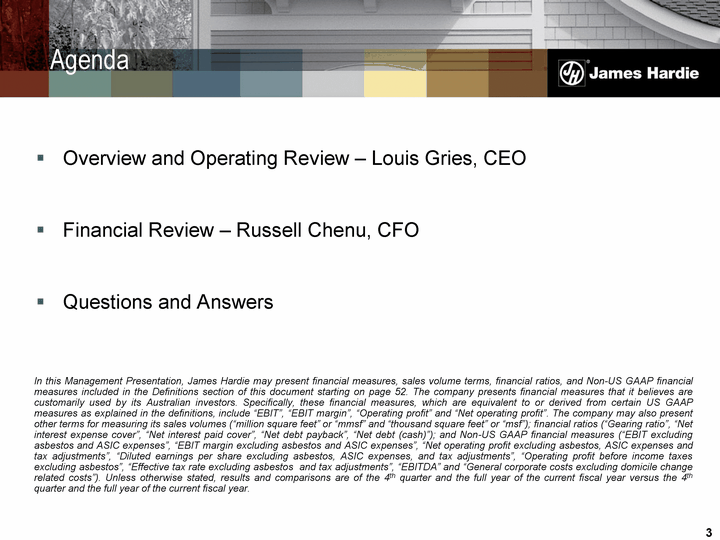
| Overview and Operating Review - Louis Gries, CEO Financial Review - Russell Chenu, CFO Questions and Answers Agenda In this Management Presentation, James Hardie may present financial measures, sales volume terms, financial ratios, and Non-US GAAP financial measures included in the Definitions section of this document starting on page 52. The company presents financial measures that it believes are customarily used by its Australian investors. Specifically, these financial measures, which are equivalent to or derived from certain US GAAP measures as explained in the definitions, include "EBIT", "EBIT margin", "Operating profit" and "Net operating profit". The company may also present other terms for measuring its sales volumes ("million square feet" or "mmsf" and "thousand square feet" or "msf"); financial ratios ("Gearing ratio", "Net interest expense cover", "Net interest paid cover", "Net debt payback", "Net debt (cash)"); and Non-US GAAP financial measures ("EBIT excluding asbestos and ASIC expenses", "EBIT margin excluding asbestos and ASIC expenses", "Net operating profit excluding asbestos, ASIC expenses and tax adjustments", "Diluted earnings per share excluding asbestos, ASIC expenses, and tax adjustments", "Operating profit before income taxes excluding asbestos", "Effective tax rate excluding asbestos and tax adjustments", "EBITDA" and "General corporate costs excluding domicile change related costs"). Unless otherwise stated, results and comparisons are of the 4th quarter and the full year of the current fiscal year versus the 4th quarter and the full year of the current fiscal year. 3 |
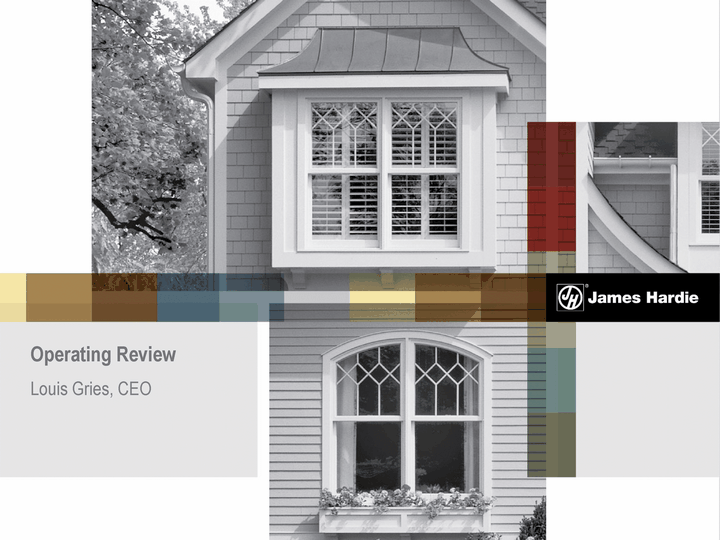
| Operating Review Louis Gries, CEO |

| Group Overview Full year operating results reflect the benefits of lower input costs, lower warranty costs, reduced SG&A expenses and a higher average net sales price, compared to FY09 The net operating result including asbestos, ASIC expenses and tax adjustments for the full year was primarily affected by an unfavourable asbestos adjustment of US$224m which is predominantly attributable to the appreciation of the A$ against the US$ 5 |

| 4th Quarter Result Net Sales up 4% to US$196.8 million Sales Volume up 2% to 314.0 mmsf Average Price up 2% to US$627 per msf EBIT up 8% to US$34.8 million EBIT Margin up 0.6 pts to 17.7% USA and Europe Fibre Cement 6 |
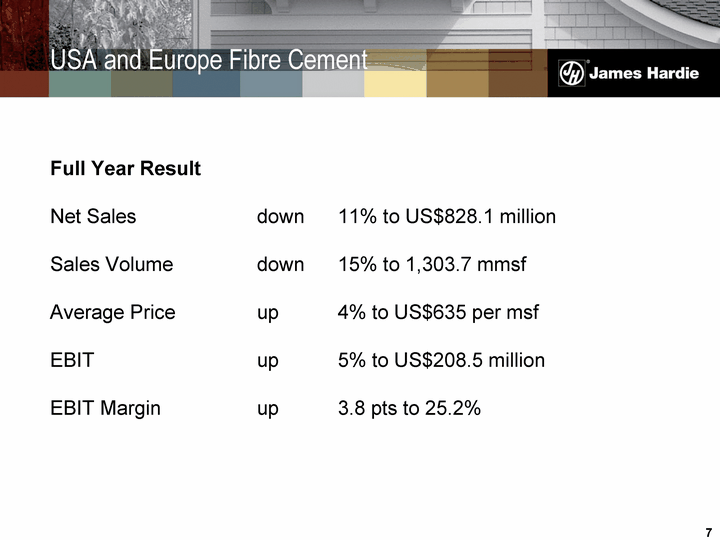
| Full Year Result Net Sales down 11% to US$828.1 million Sales Volume down 15% to 1,303.7 mmsf Average Price up 4% to US$635 per msf EBIT up 5% to US$208.5 million EBIT Margin up 3.8 pts to 25.2% USA and Europe Fibre Cement 7 |

| Average Net Sales Price US$ per MSF USA and Europe Fibre Cement US$635 8 |
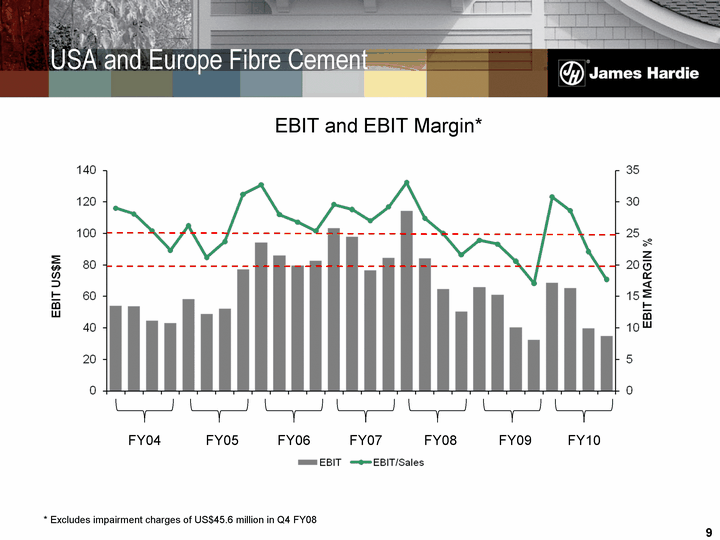
| USA and Europe Fibre Cement * Excludes impairment charges of US$45.6 million in Q4 FY08 9 EBIT and EBIT Margin* FY04 FY05 FY06 FY07 FY08 FY09 FY10 |
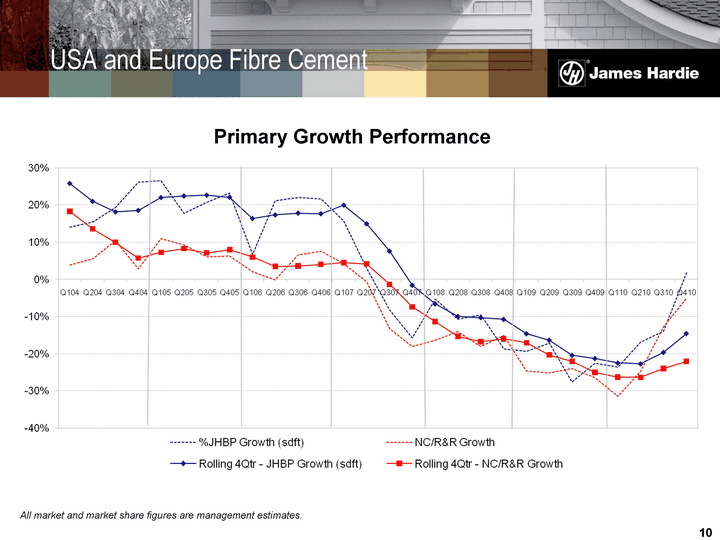
| USA and Europe Fibre Cement Primary Growth Performance All market and market share figures are management estimates. 10 |
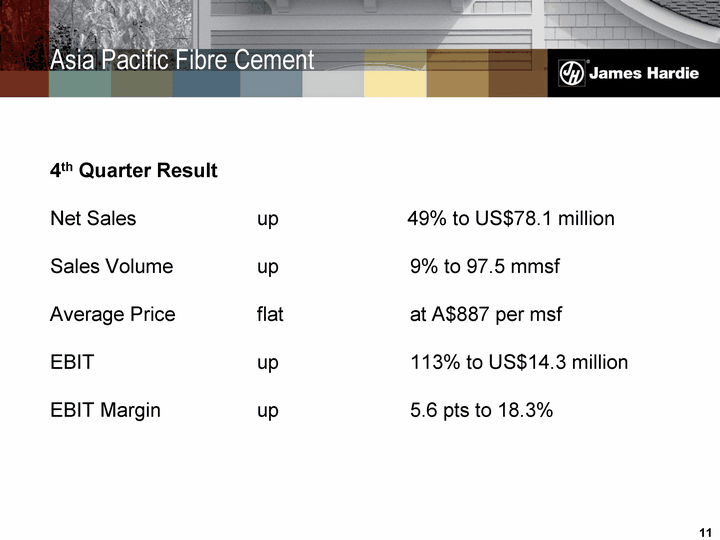
| 4th Quarter Result Net Sales up 49% to US$78.1 million Sales Volume up 9% to 97.5 mmsf Average Price flat at A$887 per msf EBIT up 113% to US$14.3 million EBIT Margin up 5.6 pts to 18.3% Asia Pacific Fibre Cement 11 |
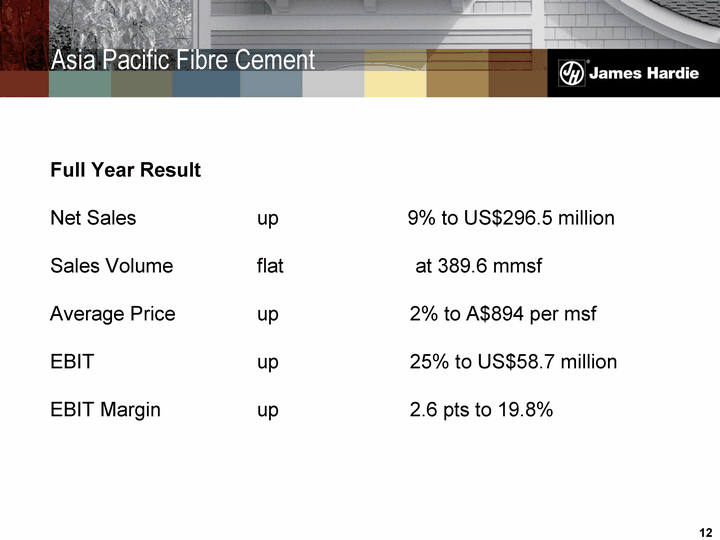
| Full Year Result Net Sales up 9% to US$296.5 million Sales Volume flat at 389.6 mmsf Average Price up 2% to A$894 per msf EBIT up 25% to US$58.7 million EBIT Margin up 2.6 pts to 19.8% Asia Pacific Fibre Cement 12 |
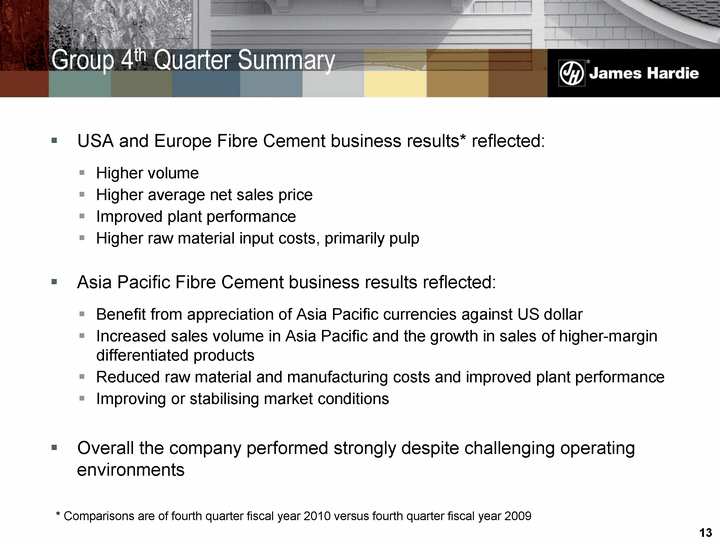
| USA and Europe Fibre Cement business results* reflected: Higher volume Higher average net sales price Improved plant performance Higher raw material input costs, primarily pulp Asia Pacific Fibre Cement business results reflected: Benefit from appreciation of Asia Pacific currencies against US dollar Increased sales volume in Asia Pacific and the growth in sales of higher-margin differentiated products Reduced raw material and manufacturing costs and improved plant performance Improving or stabilising market conditions Overall the company performed strongly despite challenging operating environments Group 4th Quarter Summary 13 * Comparisons are of fourth quarter fiscal year 2010 versus fourth quarter fiscal year 2009 |
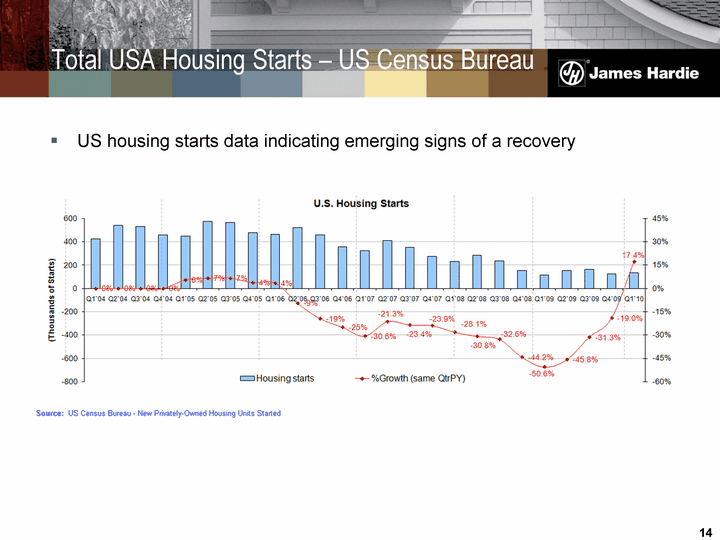
| 14 US housing starts data indicating emerging signs of a recovery Total USA Housing Starts - US Census Bureau |
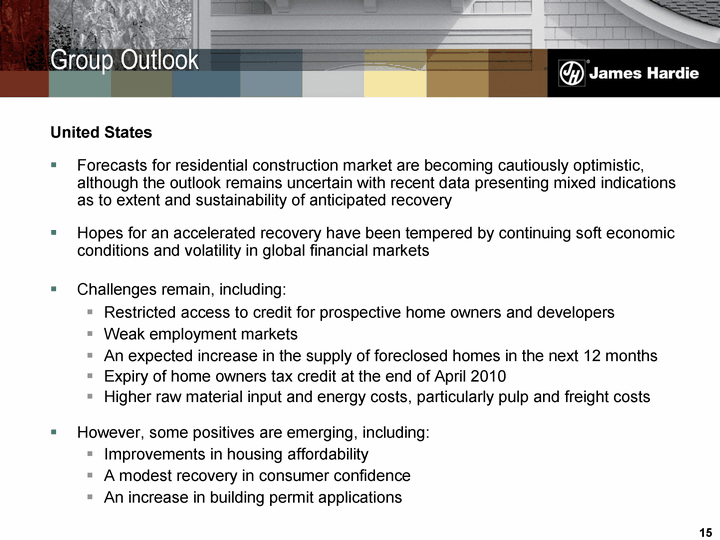
| United States Forecasts for residential construction market are becoming cautiously optimistic, although the outlook remains uncertain with recent data presenting mixed indications as to extent and sustainability of anticipated recovery Hopes for an accelerated recovery have been tempered by continuing soft economic conditions and volatility in global financial markets Challenges remain, including: Restricted access to credit for prospective home owners and developers Weak employment markets An expected increase in the supply of foreclosed homes in the next 12 months Expiry of home owners tax credit at the end of April 2010 Higher raw material input and energy costs, particularly pulp and freight costs However, some positives are emerging, including: Improvements in housing affordability A modest recovery in consumer confidence An increase in building permit applications Group Outlook 15 |
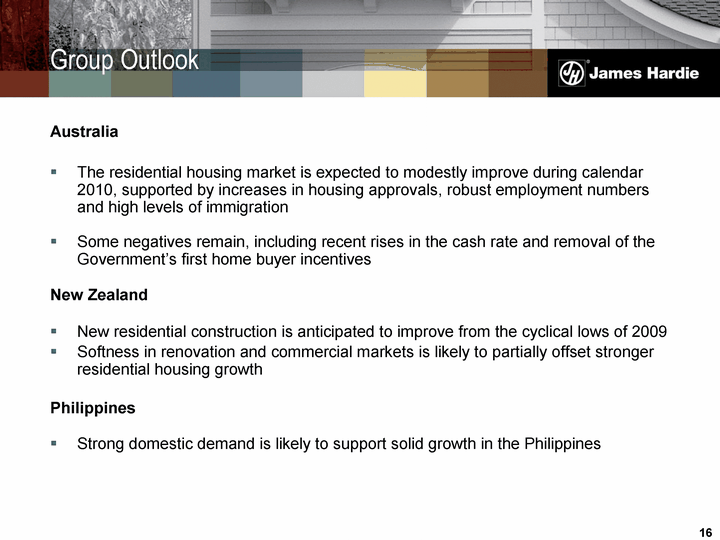
| Australia The residential housing market is expected to modestly improve during calendar 2010, supported by increases in housing approvals, robust employment numbers and high levels of immigration Some negatives remain, including recent rises in the cash rate and removal of the Government's first home buyer incentives New Zealand New residential construction is anticipated to improve from the cyclical lows of 2009 Softness in renovation and commercial markets is likely to partially offset stronger residential housing growth Philippines Strong domestic demand is likely to support solid growth in the Philippines Group Outlook 16 |
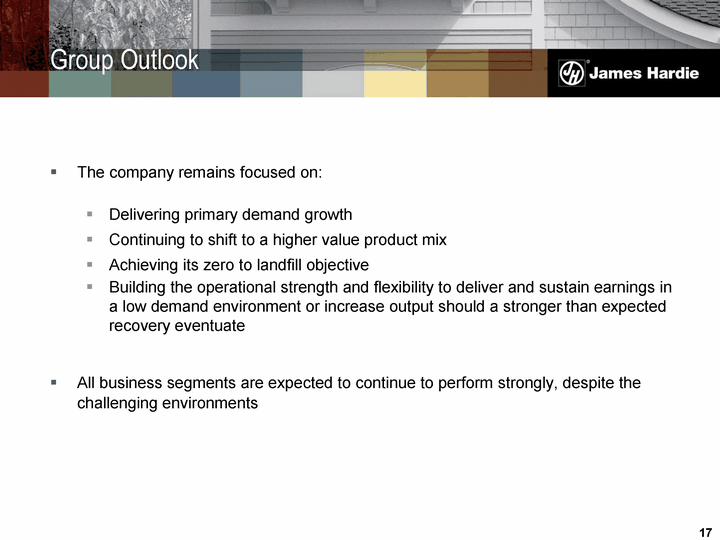
| The company remains focused on: Delivering primary demand growth Continuing to shift to a higher value product mix Achieving its zero to landfill objective Building the operational strength and flexibility to deliver and sustain earnings in a low demand environment or increase output should a stronger than expected recovery eventuate All business segments are expected to continue to perform strongly, despite the challenging environments Group Outlook 17 |
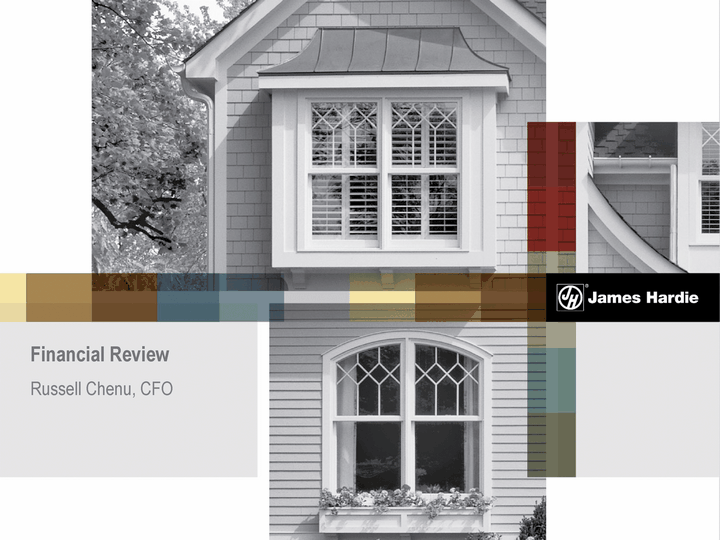
| Financial Review Russell Chenu, CFO |
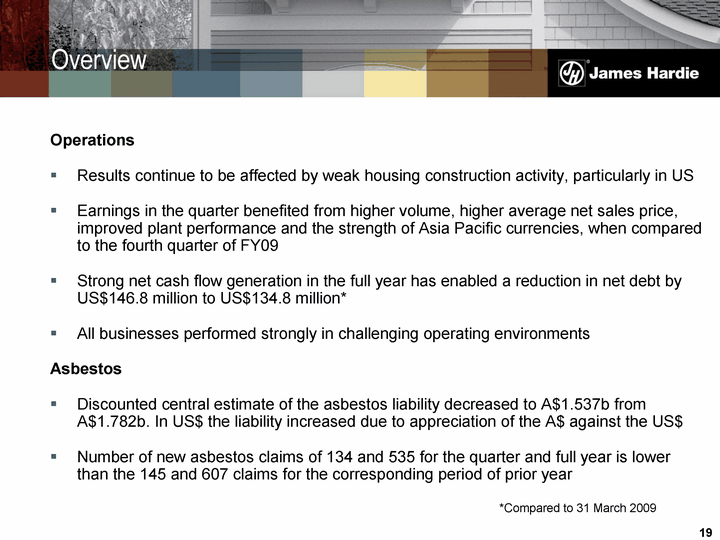
| Overview Operations Results continue to be affected by weak housing construction activity, particularly in US Earnings in the quarter benefited from higher volume, higher average net sales price, improved plant performance and the strength of Asia Pacific currencies, when compared to the fourth quarter of FY09 Strong net cash flow generation in the full year has enabled a reduction in net debt by US$146.8 million to US$134.8 million* All businesses performed strongly in challenging operating environments Asbestos Discounted central estimate of the asbestos liability decreased to A$1.537b from A$1.782b. In US$ the liability increased due to appreciation of the A$ against the US$ Number of new asbestos claims of 134 and 535 for the quarter and full year is lower than the 145 and 607 claims for the corresponding period of prior year 19 *Compared to 31 March 2009 |
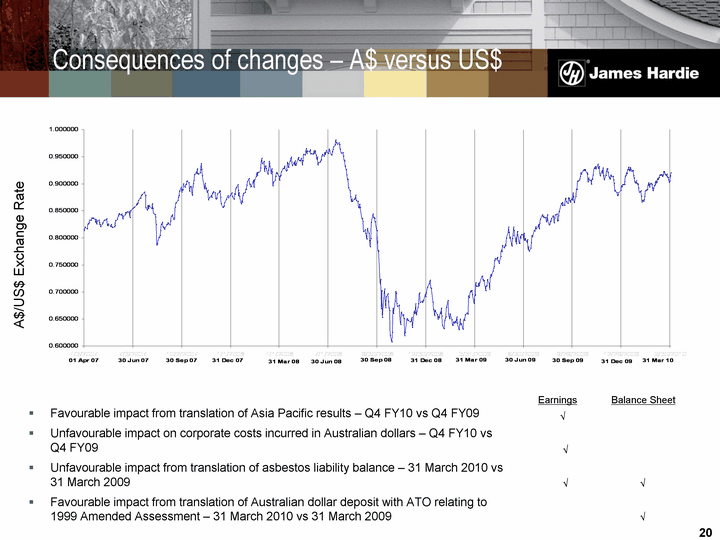
| Consequences of changes - A$ versus US$ A$/US$ Exchange Rate Favourable impact from translation of Asia Pacific results - Q4 FY10 vs Q4 FY09 Unfavourable impact on corporate costs incurred in Australian dollars - Q4 FY10 vs Q4 FY09 Unfavourable impact from translation of asbestos liability balance - 31 March 2010 vs 31 March 2009 Favourable impact from translation of Australian dollar deposit with ATO relating to 1999 Amended Assessment - 31 March 2010 vs 31 March 2009 Earnings Balance Sheet ^ ^ ^ ^ ^ 20 |
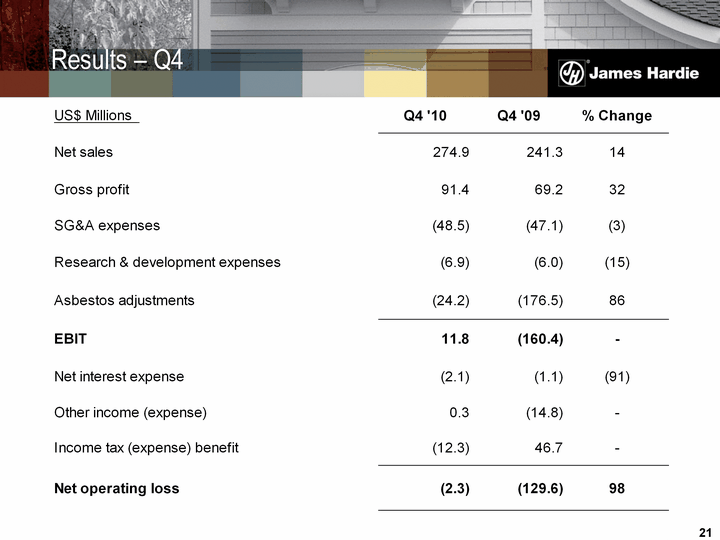
| Results - Q4 21 |
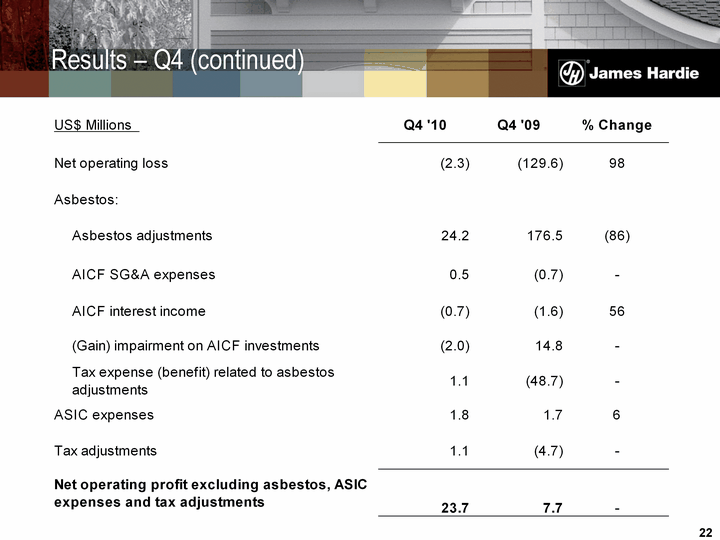
| Results - Q4 (continued) 22 |
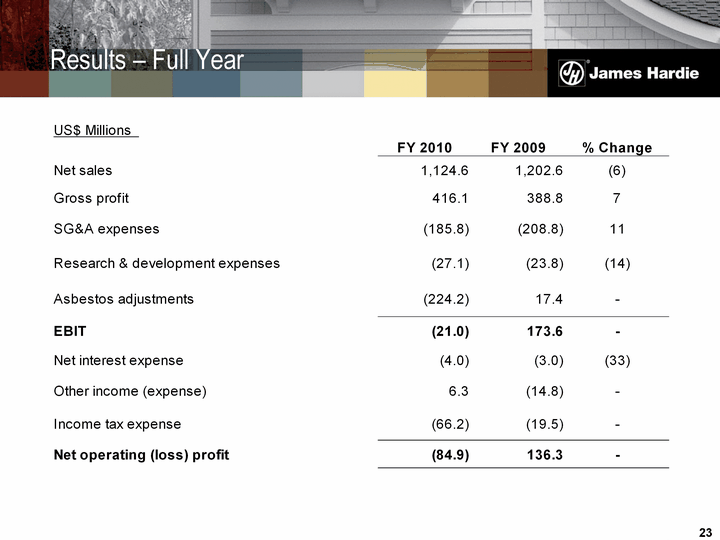
| Results - Full Year 23 |
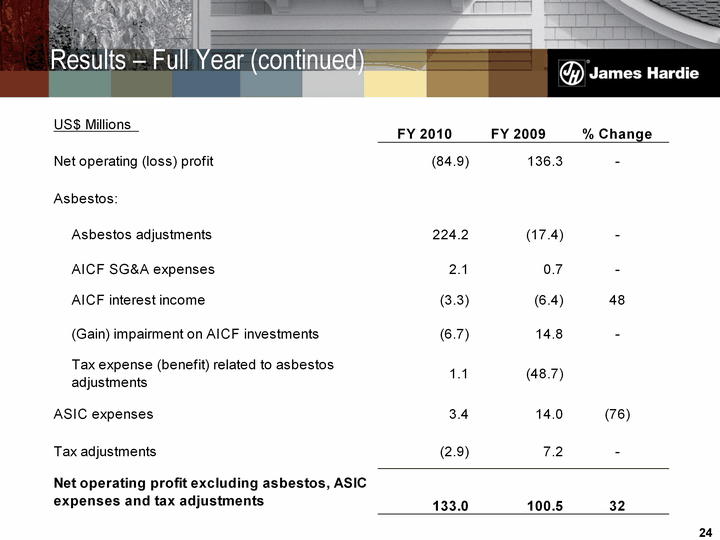
| Results - Full Year (continued) 24 |
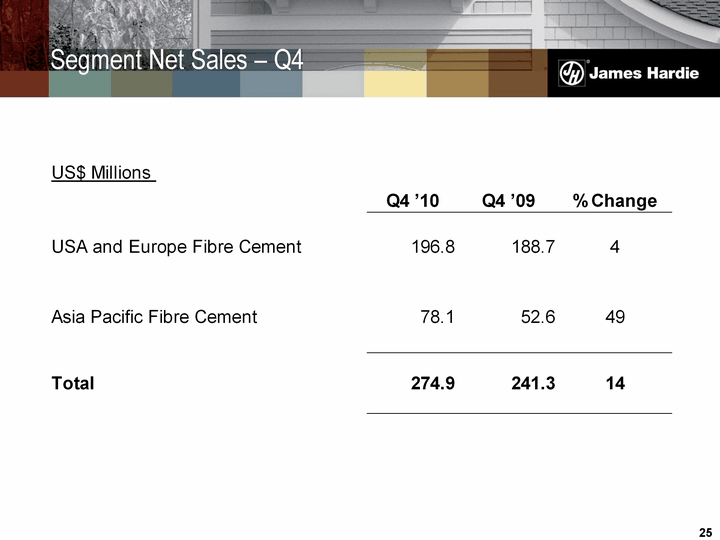
| Segment Net Sales - Q4 25 |
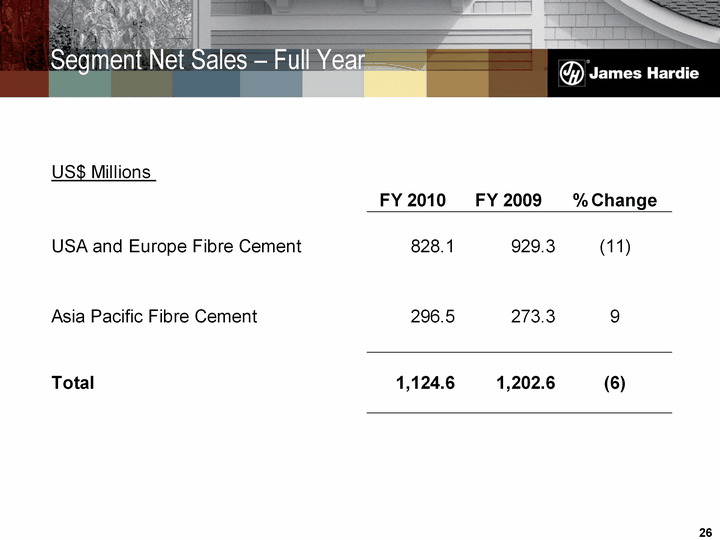
| Segment Net Sales - Full Year 26 |
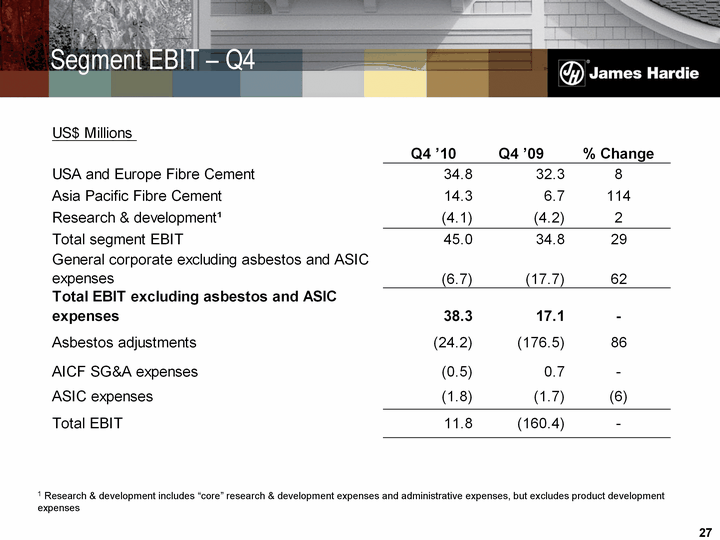
| 1 Research & development includes "core" research & development expenses and administrative expenses, but excludes product development expenses Segment EBIT - Q4 27 |
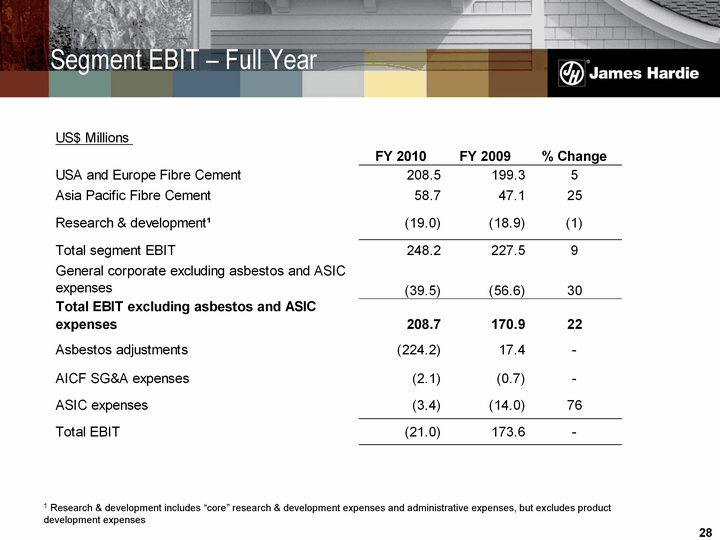
| 1 Research & development includes "core" research & development expenses and administrative expenses, but excludes product development expenses Segment EBIT - Full Year 28 |
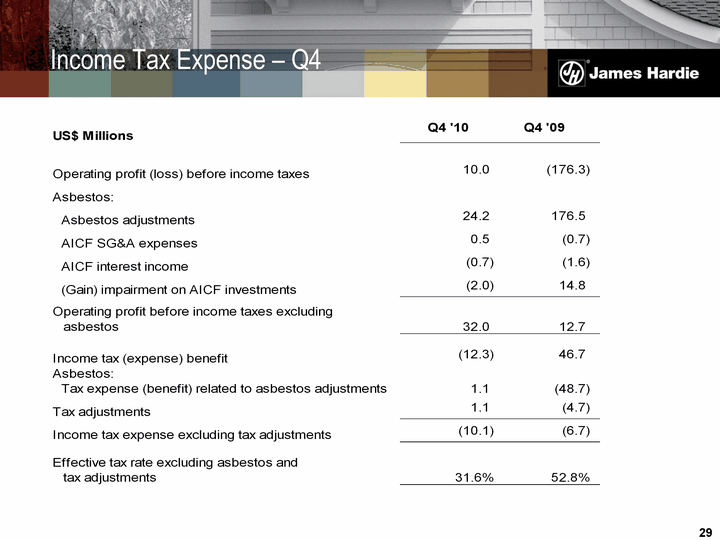
| Income Tax Expense - Q4 29 |
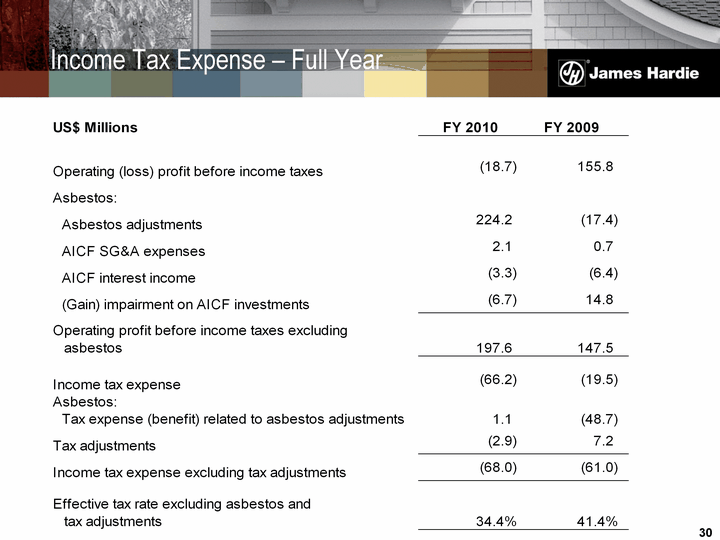
| Income Tax Expense - Full Year 30 |
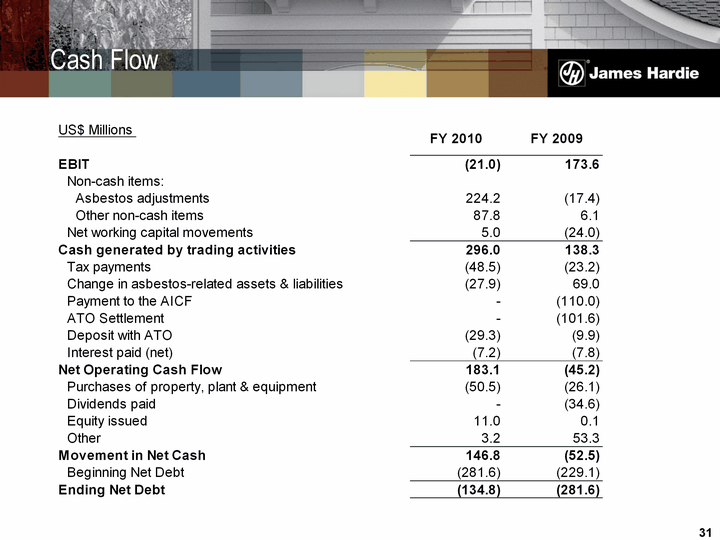
| Cash Flow 31 |

| Debt Net debt decreased by US$146.8 million compared to net debt at 31 March 2009 In December 2009, the company refinanced US$130 m of US$150 m in facilities which previously had maturity dates in or prior to June 2010. These will expire December 2012 Weighted average remaining term of total facilities was 2.6 years at 31 March 2010 up from 1.6 years at 31 March 2010 James Hardie remains well within its financial debt covenants At 31 March 2010 32 |
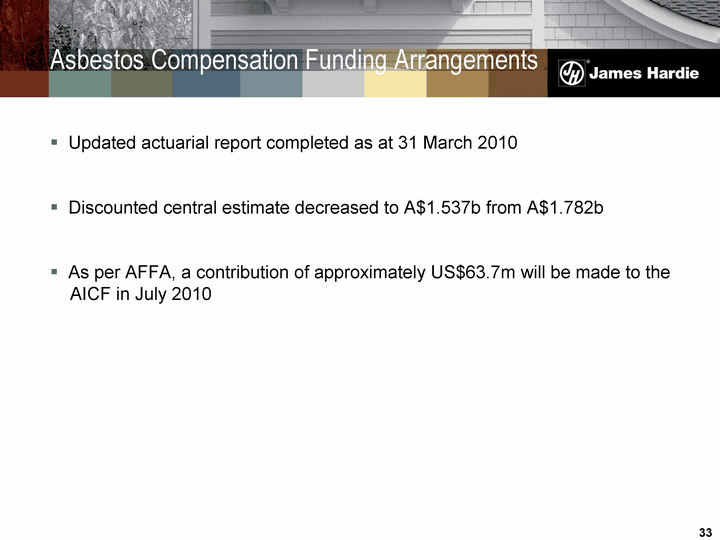
| Updated actuarial report completed as at 31 March 2010 Discounted central estimate decreased to A$1.537b from A$1.782b As per AFFA, a contribution of approximately US$63.7m will be made to the AICF in July 2010 Asbestos Compensation Funding Arrangements 33 |
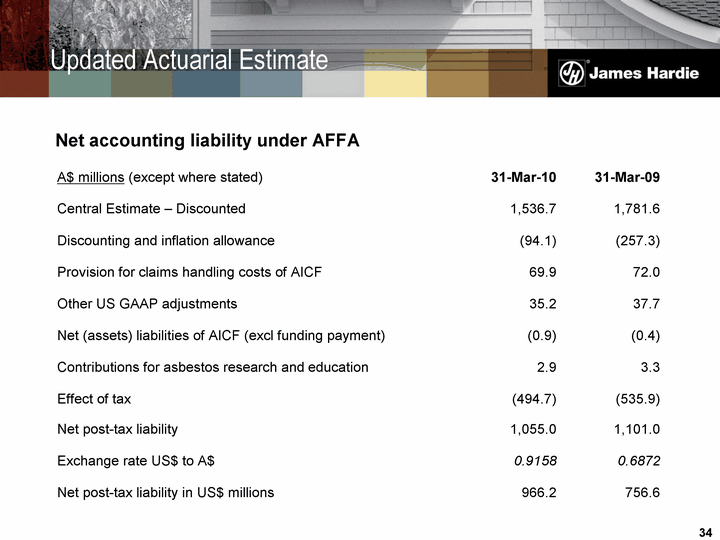
| 34 Net accounting liability under AFFA A$ millions (except where stated) 31-Mar-10 31-Mar-09 Central Estimate - Discounted 1,536.7 1,781.6 Discounting and inflation allowance (94.1) (257.3) Provision for claims handling costs of AICF 69.9 72.0 Other US GAAP adjustments 35.2 37.7 Net (assets) liabilities of AICF (excl funding payment) (0.9) (0.4) Contributions for asbestos research and education 2.9 3.3 Effect of tax (494.7) (535.9) Net post-tax liability 1,055.0 1,101.0 Exchange rate US$ to A$ 0.9158 0.6872 Net post-tax liability in US$ millions 966.2 756.6 Updated Actuarial Estimate |
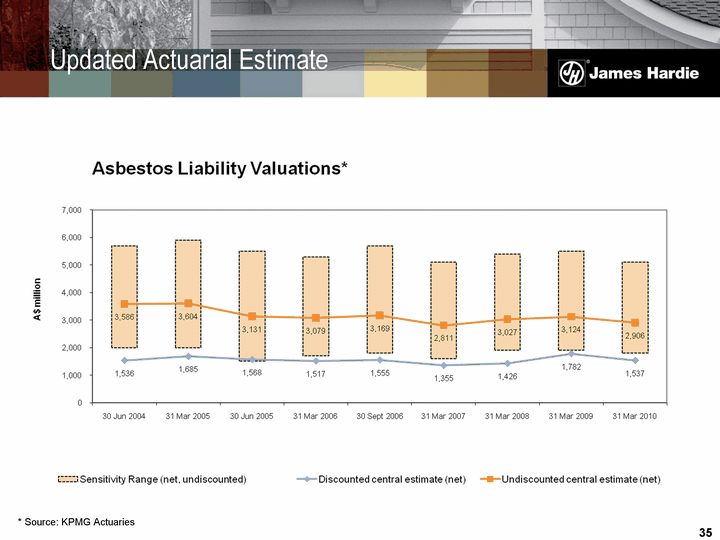
| 35 * Source: KPMG Actuaries Updated Actuarial Estimate |
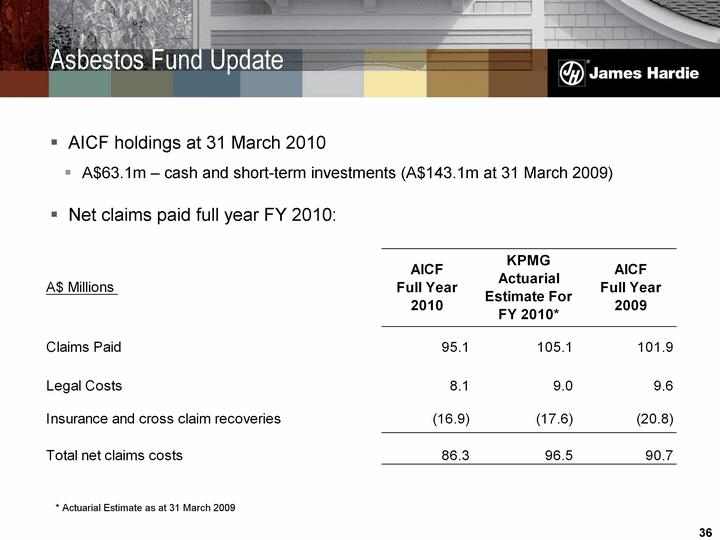
| AICF holdings at 31 March 2010 A$63.1m - cash and short-term investments (A$143.1m at 31 March 2009) Net claims paid full year FY 2010: * Actuarial Estimate as at 31 March 2009 Asbestos Fund Update 36 |
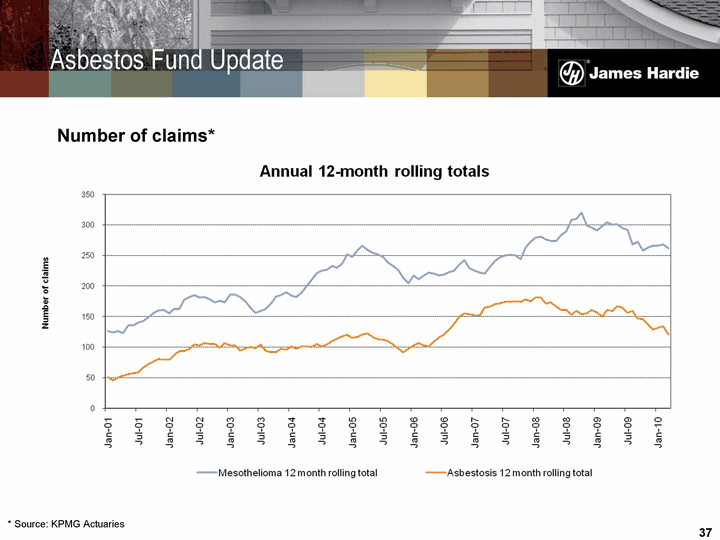
| Asbestos Fund Update 37 Number of claims* * Source: KPMG Actuaries |
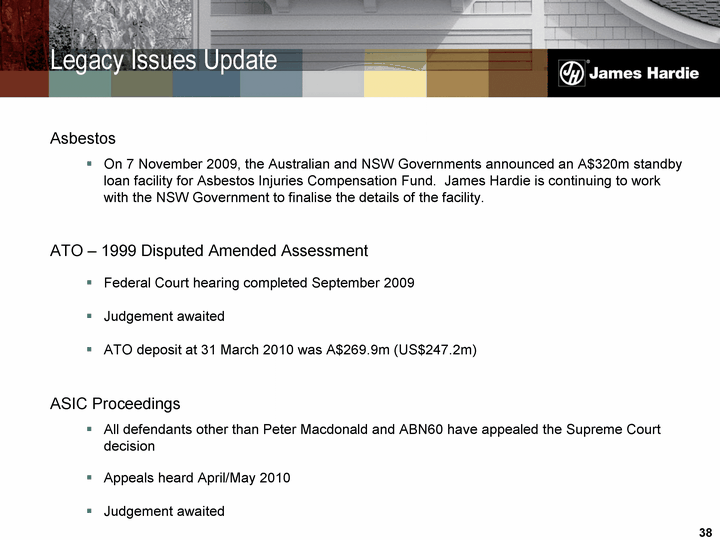
| Legacy Issues Update Asbestos On 7 November 2009, the Australian and NSW Governments announced an A$320m standby loan facility for Asbestos Injuries Compensation Fund. James Hardie is continuing to work with the NSW Government to finalise the details of the facility. ATO - 1999 Disputed Amended Assessment Federal Court hearing completed September 2009 Judgement awaited ATO deposit at 31 March 2010 was A$269.9m (US$247.2m) ASIC Proceedings All defendants other than Peter Macdonald and ABN60 have appealed the Supreme Court decision Appeals heard April/May 2010 Judgement awaited 38 |
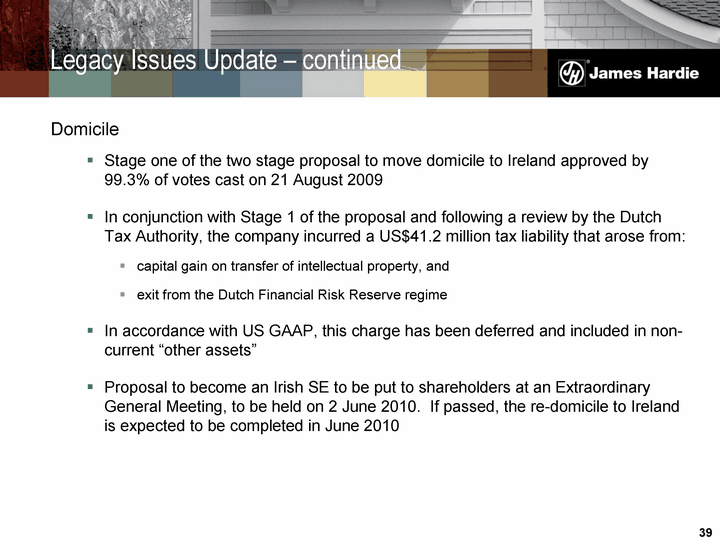
| Legacy Issues Update - continued Domicile Stage one of the two stage proposal to move domicile to Ireland approved by 99.3% of votes cast on 21 August 2009 In conjunction with Stage 1 of the proposal and following a review by the Dutch Tax Authority, the company incurred a US$41.2 million tax liability that arose from: capital gain on transfer of intellectual property, and exit from the Dutch Financial Risk Reserve regime In accordance with US GAAP, this charge has been deferred and included in non- current "other assets" Proposal to become an Irish SE to be put to shareholders at an Extraordinary General Meeting, to be held on 2 June 2010. If passed, the re-domicile to Ireland is expected to be completed in June 2010 39 |

| Key Ratios 1 Excludes asbestos adjustments, AICF SG&A expenses, AICF interest income, gain or impairment on AICF investments, ASIC expenses, tax adjustments and asset impairments 2 Excludes asbestos adjustments, AICF SG&A expenses, ASIC expenses and asset impairments 3 Excludes payments under the Amended FFA 40 |
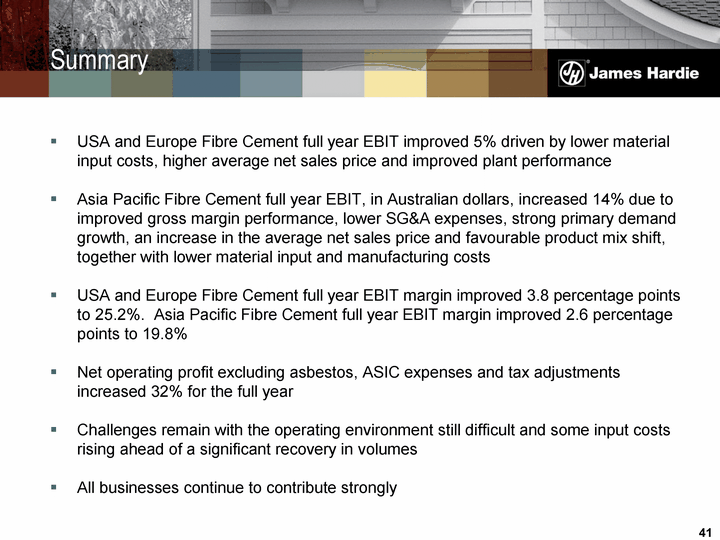
| USA and Europe Fibre Cement full year EBIT improved 5% driven by lower material input costs, higher average net sales price and improved plant performance Asia Pacific Fibre Cement full year EBIT, in Australian dollars, increased 14% due to improved gross margin performance, lower SG&A expenses, strong primary demand growth, an increase in the average net sales price and favourable product mix shift, together with lower material input and manufacturing costs USA and Europe Fibre Cement full year EBIT margin improved 3.8 percentage points to 25.2%. Asia Pacific Fibre Cement full year EBIT margin improved 2.6 percentage points to 19.8% Net operating profit excluding asbestos, ASIC expenses and tax adjustments increased 32% for the full year Challenges remain with the operating environment still difficult and some input costs rising ahead of a significant recovery in volumes All businesses continue to contribute strongly Summary 41 |
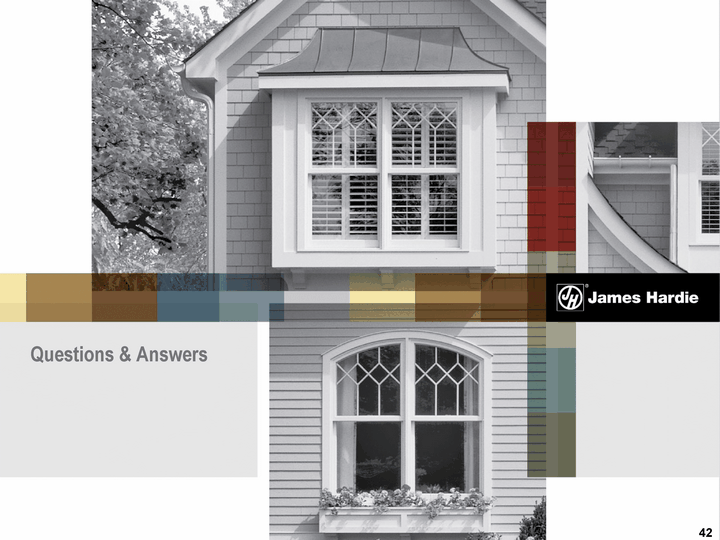
| Questions & Answers 42 |
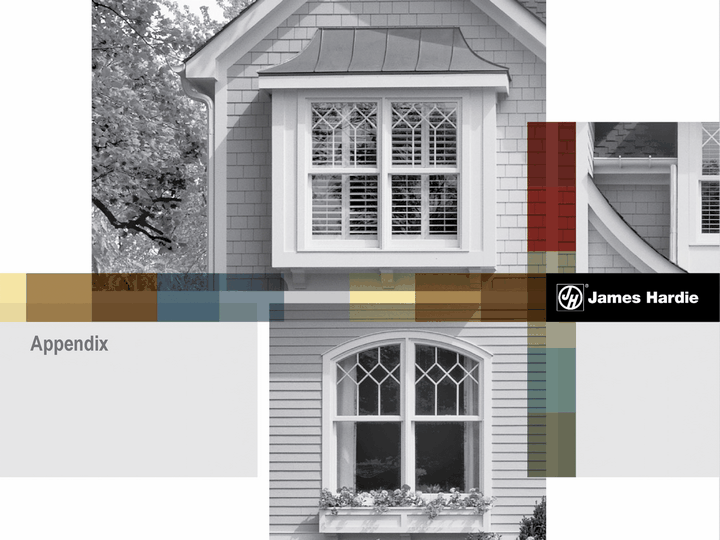
| Appendix |
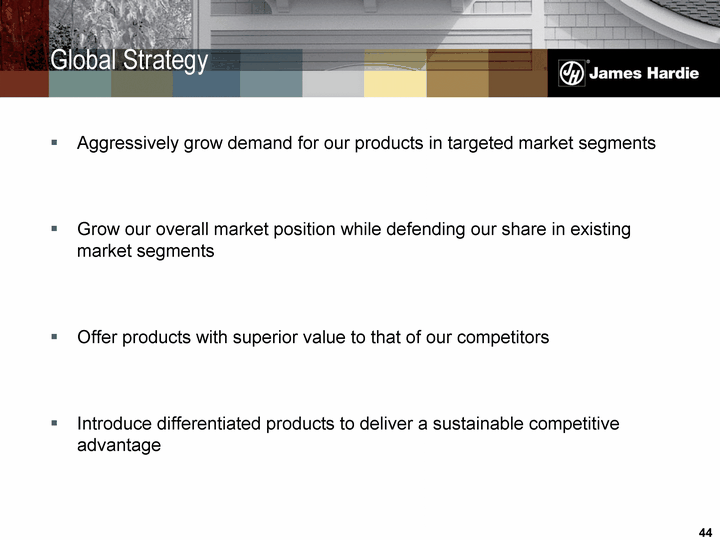
| Aggressively grow demand for our products in targeted market segments Grow our overall market position while defending our share in existing market segments Offer products with superior value to that of our competitors Introduce differentiated products to deliver a sustainable competitive advantage Global Strategy 44 |
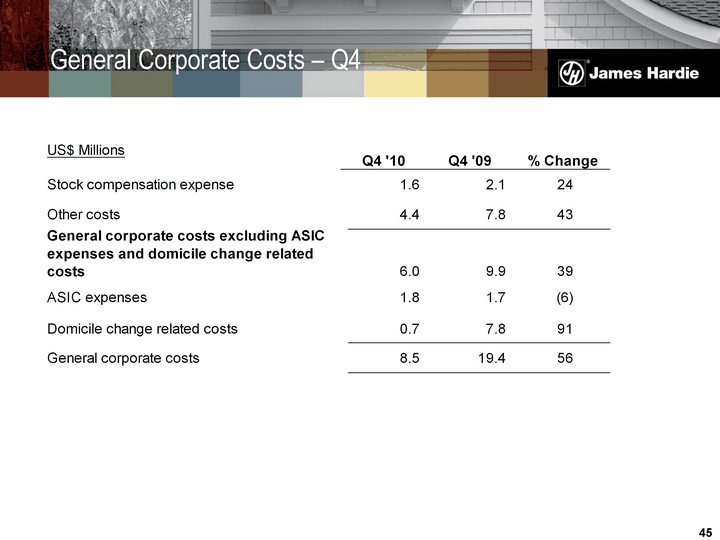
| General Corporate Costs - Q4 45 |
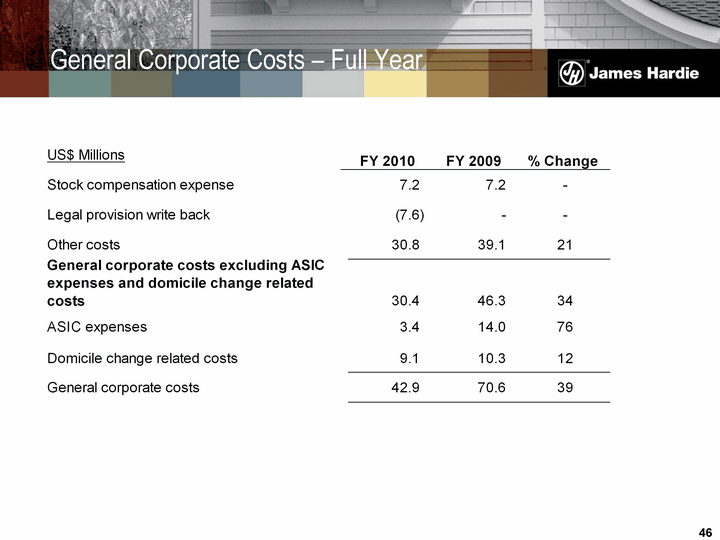
| General Corporate Costs - Full Year 46 |
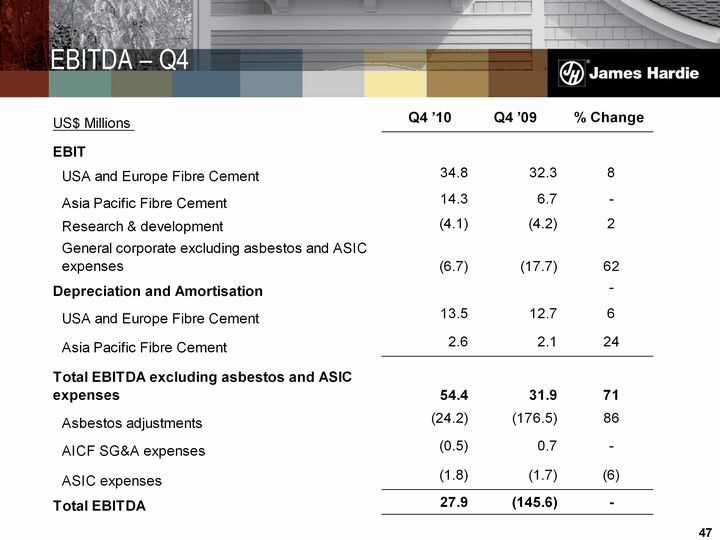
| EBITDA - Q4 47 |

| EBITDA - Full Year 48 |
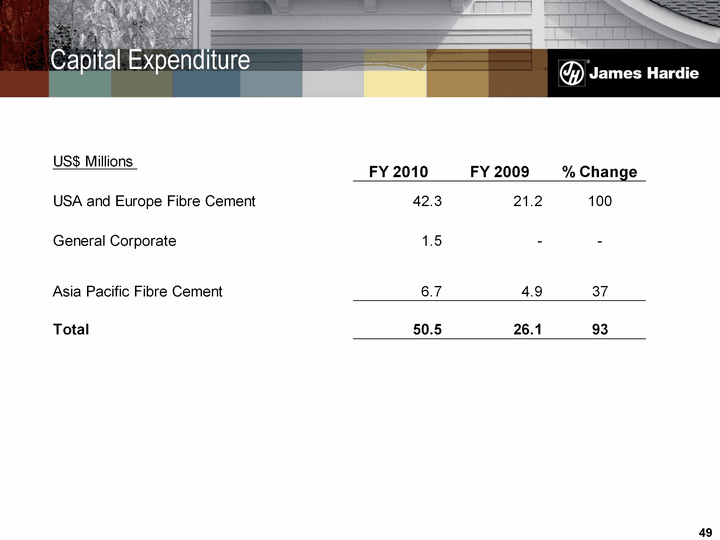
| Capital Expenditure 49 |
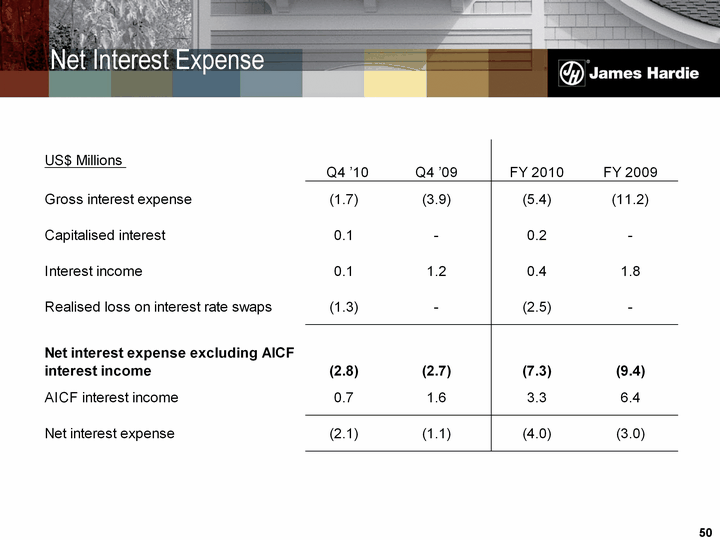
| Net Interest Expense 50 |
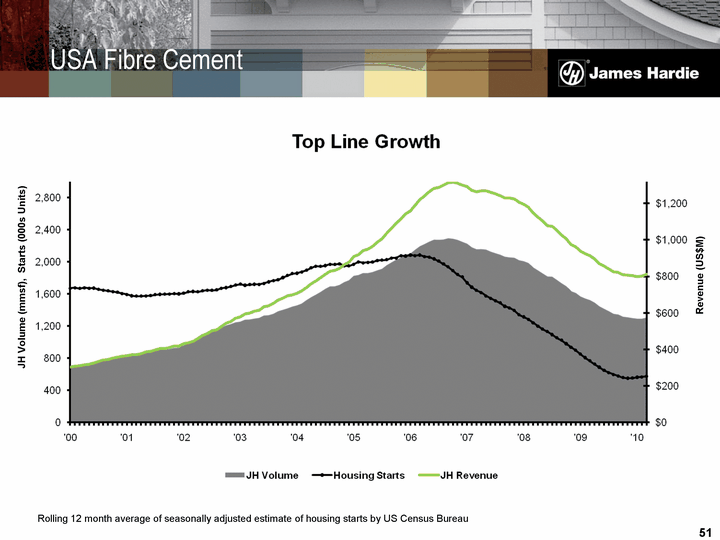
| USA Fibre Cement Rolling 12 month average of seasonally adjusted estimate of housing starts by US Census Bureau JH Volume (mmsf), Starts (000s Units) Revenue (US$M) 51 |
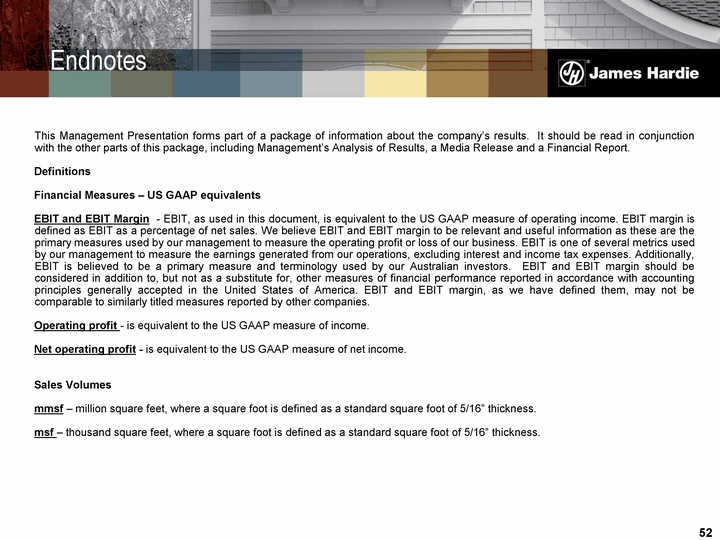
| Endnotes This Management Presentation forms part of a package of information about the company's results. It should be read in conjunction with the other parts of this package, including Management's Analysis of Results, a Media Release and a Financial Report. Definitions Financial Measures - US GAAP equivalents EBIT and EBIT Margin - EBIT, as used in this document, is equivalent to the US GAAP measure of operating income. EBIT margin is defined as EBIT as a percentage of net sales. We believe EBIT and EBIT margin to be relevant and useful information as these are the primary measures used by our management to measure the operating profit or loss of our business. EBIT is one of several metrics used by our management to measure the earnings generated from our operations, excluding interest and income tax expenses. Additionally, EBIT is believed to be a primary measure and terminology used by our Australian investors. EBIT and EBIT margin should be considered in addition to, but not as a substitute for, other measures of financial performance reported in accordance with accounting principles generally accepted in the United States of America. EBIT and EBIT margin, as we have defined them, may not be comparable to similarly titled measures reported by other companies. Operating profit - is equivalent to the US GAAP measure of income. Net operating profit - is equivalent to the US GAAP measure of net income. Sales Volumes mmsf - million square feet, where a square foot is defined as a standard square foot of 5/16" thickness. msf - thousand square feet, where a square foot is defined as a standard square foot of 5/16" thickness. 52 |
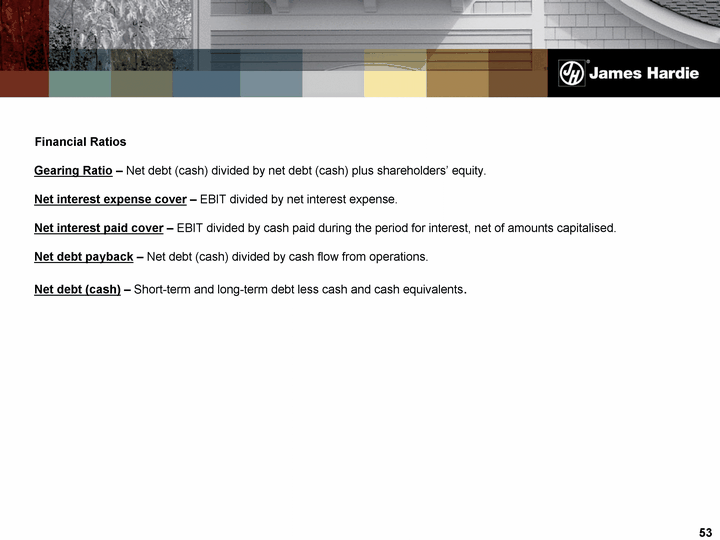
| Financial Ratios Gearing Ratio - Net debt (cash) divided by net debt (cash) plus shareholders' equity. Net interest expense cover - EBIT divided by net interest expense. Net interest paid cover - EBIT divided by cash paid during the period for interest, net of amounts capitalised. Net debt payback - Net debt (cash) divided by cash flow from operations. Net debt (cash) - Short-term and long-term debt less cash and cash equivalents. 53 |

| Non-US GAAP Financial Measures EBIT and EBIT margin excluding asbestos and ASIC expenses - EBIT and EBIT margin excluding asbestos and ASIC expenses are not measures of financial performance under US GAAP and should not be considered to be more meaningful than EBIT and EBIT margin. James Hardie has included these financial measures to provide investors with an alternative method for assessing its operating results in a manner that is focussed on the performance of its ongoing operations and provides useful information regarding its financial condition and results of operations. The company uses these non-US GAAP measures for the same purposes. 54 |
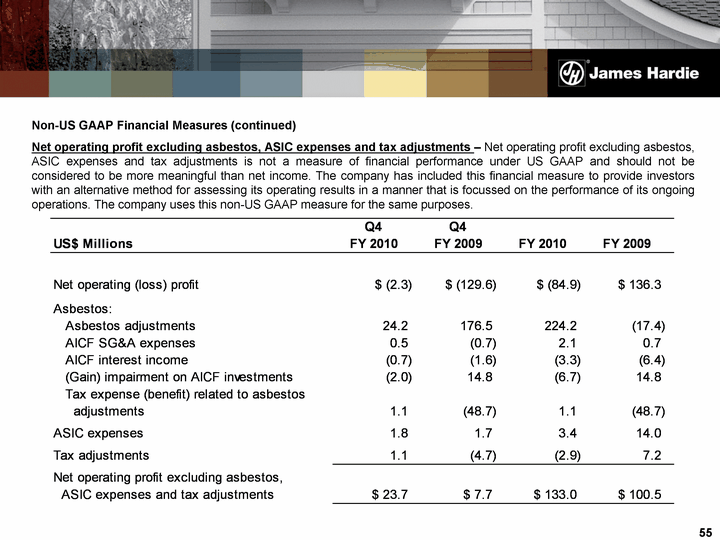
| Non-US GAAP Financial Measures (continued) Net operating profit excluding asbestos, ASIC expenses and tax adjustments - Net operating profit excluding asbestos, ASIC expenses and tax adjustments is not a measure of financial performance under US GAAP and should not be considered to be more meaningful than net income. The company has included this financial measure to provide investors with an alternative method for assessing its operating results in a manner that is focussed on the performance of its ongoing operations. The company uses this non-US GAAP measure for the same purposes. 55 |
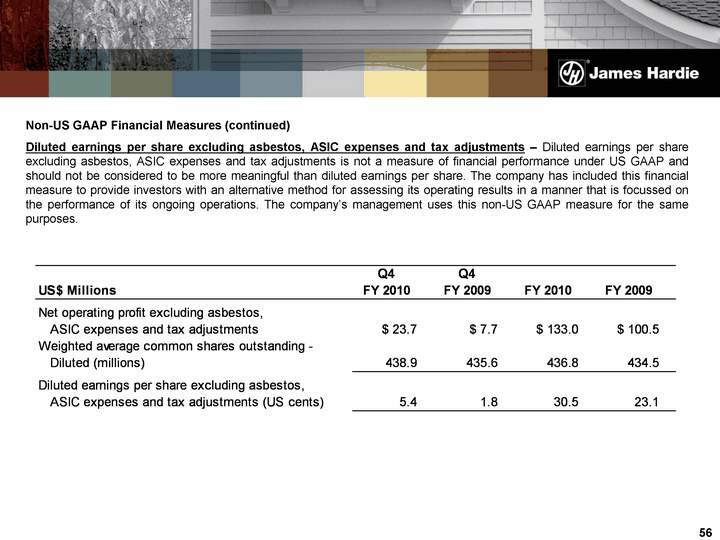
| Non-US GAAP Financial Measures (continued) Diluted earnings per share excluding asbestos, ASIC expenses and tax adjustments - Diluted earnings per share excluding asbestos, ASIC expenses and tax adjustments is not a measure of financial performance under US GAAP and should not be considered to be more meaningful than diluted earnings per share. The company has included this financial measure to provide investors with an alternative method for assessing its operating results in a manner that is focussed on the performance of its ongoing operations. The company's management uses this non-US GAAP measure for the same purposes. 56 |
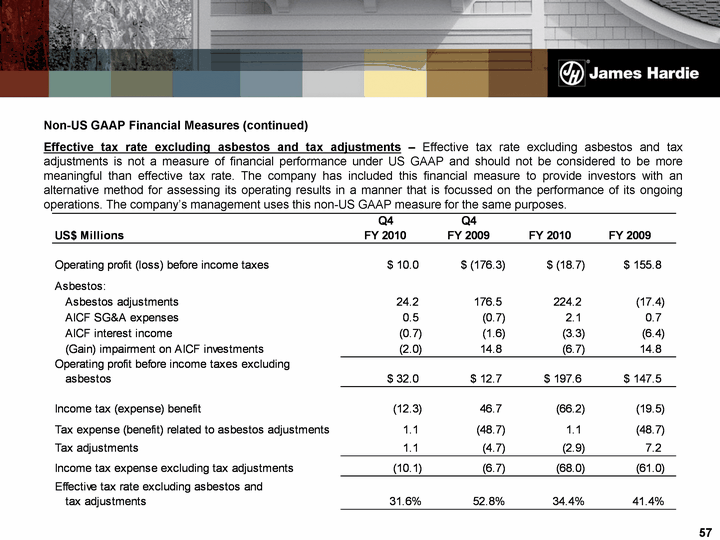
| Non-US GAAP Financial Measures (continued) Effective tax rate excluding asbestos and tax adjustments - Effective tax rate excluding asbestos and tax adjustments is not a measure of financial performance under US GAAP and should not be considered to be more meaningful than effective tax rate. The company has included this financial measure to provide investors with an alternative method for assessing its operating results in a manner that is focussed on the performance of its ongoing operations. The company's management uses this non-US GAAP measure for the same purposes. 57 |
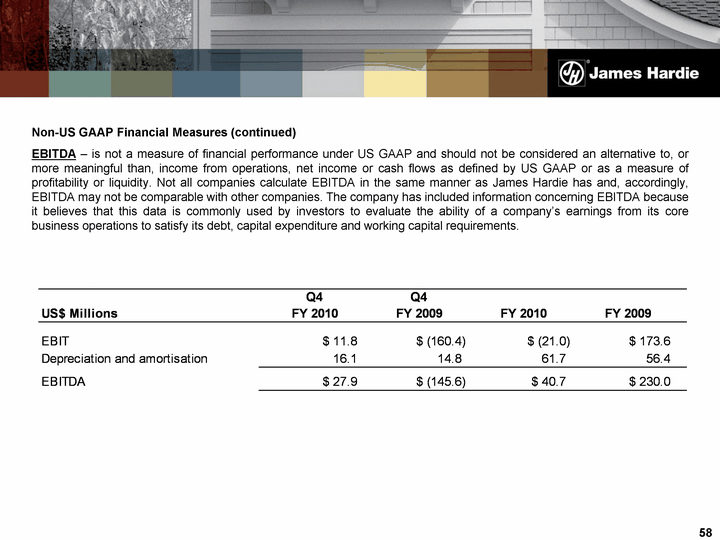
| Non-US GAAP Financial Measures (continued) EBITDA - is not a measure of financial performance under US GAAP and should not be considered an alternative to, or more meaningful than, income from operations, net income or cash flows as defined by US GAAP or as a measure of profitability or liquidity. Not all companies calculate EBITDA in the same manner as James Hardie has and, accordingly, EBITDA may not be comparable with other companies. The company has included information concerning EBITDA because it believes that this data is commonly used by investors to evaluate the ability of a company's earnings from its core business operations to satisfy its debt, capital expenditure and working capital requirements. 58 |
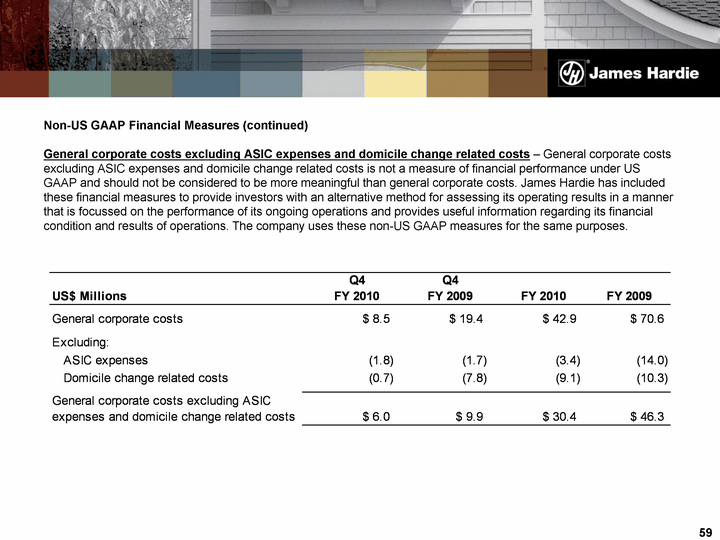
| Non-US GAAP Financial Measures (continued) General corporate costs excluding ASIC expenses and domicile change related costs - General corporate costs excluding ASIC expenses and domicile change related costs is not a measure of financial performance under US GAAP and should not be considered to be more meaningful than general corporate costs. James Hardie has included these financial measures to provide investors with an alternative method for assessing its operating results in a manner that is focussed on the performance of its ongoing operations and provides useful information regarding its financial condition and results of operations. The company uses these non-US GAAP measures for the same purposes. 59 |
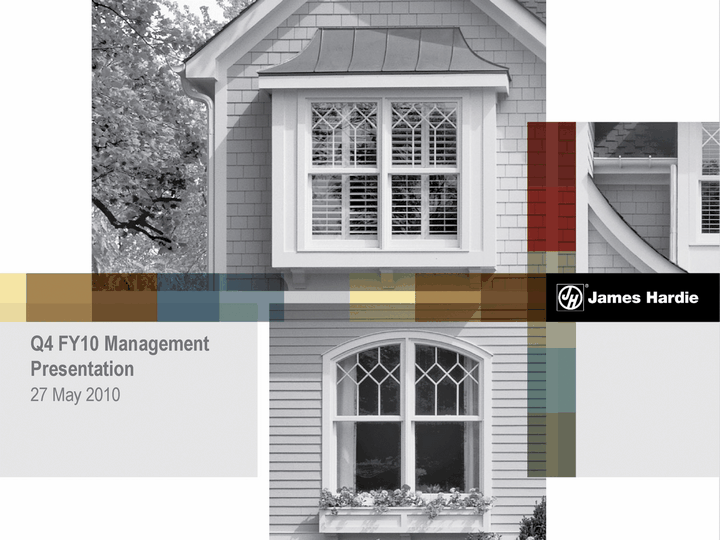
| Q4 FY10 Management Presentation 27 May 2010 |